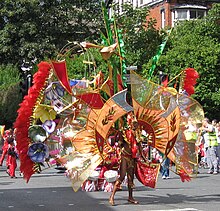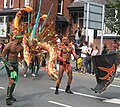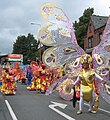
The Leeds Carnival, also called the Leeds West Indian Carnival or the Chapeltown Carnival, is one of the longest running West Indian carnivals in Europe, having been going since 1967. The carnival is held in the Chapeltown and Harehills parts of Leeds every August bank holiday weekend. Attendance is estimated at 150,000.
It is a three-day event, climaxing in a carnival procession on Bank Holiday Monday, which starts and finishes in Potternewton Park in Chapeltown. A parade of floats and dancers makes its way along Harehills Avenue, down Roundhay Road in Harehills, along Barrack Road and back along Chapeltown Road to the park, where a wide range of stages and stalls provide entertainment and refreshment for carnival-goers. Since 2005 this event has been covered by BBC Radio 1Xtra in conjunction with Notting Hill Carnival.
Carnival Queen and King


The Carnival Queen is chosen on the Friday before the main event, and in 2008 for the first time a Carnival King was chosen: they were Davina Williams and Tyrone Henry. The 2009 King and Queen were Tony and Nicole Isles, who are father and daughter.
History
Its founders were Arthur France, then a Leeds University student from Nevis, who is longstanding Chairman; Ian Charles, who was still Co-ordinator in 2008; and Gertrude Paul, a teacher. Arthur France proposed what would be the first Caribbean-style outdoor carnival organized by people of Caribbean origin in Europe. As the local Caribbean association was not forthcoming, he formed his own committee, and Ian Charles's home became a factory for costumes. Five contestants entered the first Carnival Queen Show, won by Vicky Seal as the Sun Goddess. They joined bands and dancers in a procession from Potternewton Park to Leeds Town Hall, where a steel band competition was followed by a dance. About 1,000 people attended. The Leeds performers were invited to participate in the Notting Hill Carnival later the same year.
In the 1970s a procession route was established from Potternewton Park and back again via the city centre. The steel bands were on human-powered wheeled platforms. In 1977 crowds of 10,000 were reported.
The 1980s established a shorter route around Chapeltown and Harehills, and also sponsorship by local organizations. A Carnival Prince and Princess (children aged three to 13) were also chosen. Attendance reached 40,000 in 1988.
In 1990 three people died during violence in the area afterwards. The decade saw increased professionalism by the now very experienced Carnival Committee and the introduction of lorries to carry bands. 1997 was the 30th anniversary and Arthur France received the MBE for his work with the local community.
2007 was the 40th anniversary, with crowds of 100,000 for the first time. It was also the 25th anniversary of the Leeds West Indian Centre, and the bicentenary of the British abolition of transatlantic slavery. Ian Charles also received the MBE.
In 2020 it was cancelled for the first time, because of the COVID-19 pandemic. It returned in 2022.
Gallery
-
Carnival Procession 2007
-
 Carnival Procession 2007
Carnival Procession 2007
-
 Carnival Procession 2008
Carnival Procession 2008
-
 Carnival Procession 2008
Carnival Procession 2008
-
 Carnival Procession 2008
Carnival Procession 2008
-
 Carnival Procession 2008
Carnival Procession 2008
-
 Carnival Procession 2008
Carnival Procession 2008
-
 Carnival Procession 2008
Carnival Procession 2008
See also
References
- The last Monday in August, a holiday in England
- "Thousands attend 46th annual Leeds West Indian Carnival", BBC News, 27 August 2013.
- "What's Happening?", BBC.
- "Leeds Carnival brings city to a sizzling standstill SLIDESHOW", Yorkshire Evening Post, 26 August 2008.
- "Thousands attend oldest carnival", BBC News. 31 August 2009.
- "Carnival Through the Years, 1967". Leeds West Indian Carnival Website. Archived from the original on 11 November 2007. Retrieved 28 August 2008.
- Milla Cozart Riggio (2004). Carnival: Culture in Action – The Trinidad Experience. Routledge. pp. 259. ISBN 9781134487806.
- ^ Max Farrar, "A short history of the Leeds West Indian Carnival 1967-2000".
- Yorkshire Evening Post, 28 August 1990.
- ^ "Leeds Carnival's 100,000 crowd breaks record", Yorkshire Evening Post 28 August 2007.
- Marano, Rebecca (31 August 2020). "16 amazing, colourful photos of Leeds West Indian Carnival over the years - Leeds West Indian Carnival in Chapeltown is one of the most loved events in the city's calendar". Yorkshire Evening Post. Leeds.
- Coates, Tom (29 August 2022). "Leeds West Indian Carnival 2022: Best pictures from the return of the festivities including parade - The Leeds West Indian Carnival returned for 2022 and the Yorkshire Evening Post was in attendance to capture the action". Yorkshire Evening Post. Leeds.
Further reading
- Farrar, Guy; Smith, Tim; Farrar, Max (2017). Celebrate!: 50 Years of Leeds West Indian Carnival. Northern Arts Publications. ISBN 978-1911148180.
- Zobel Marshall, Emily (2019) 'It's not all Sequins and Bikinis? Power, Performance and Play in the Leeds and Trinidad Carnival'. Turning Tides: Caribbean Intersections in the Americas and Beyond. Heather Cateau and Milla Riggio, eds. (Kingston, Jamaica: Ian Randle Publishers).
- Farrar, Guy, Farrar, Max and Zobel Marshall, Emily (2018) 'The Leeds West Indian Carnival is Fifty: Marking its African, Asian and European Heritage'. Leeds African Studies Bulletin. Issue 79. (Winter 2017/18).
- Farrar, Guy, Farrar, Max and Zobel Marshall, Emily (2017) 'Popular Political Culture and the Caribbean Carnival.' Soundings. Issue 67. (Lawrence and Wishart).
External links
- www.leedscarnival.co.uk Leeds Carnival Organizers' website
- "Mas Media – Leeds Carnival Blog". leedsmasmedia.wordpress.com. Wordpress. Retrieved 30 June 2019.